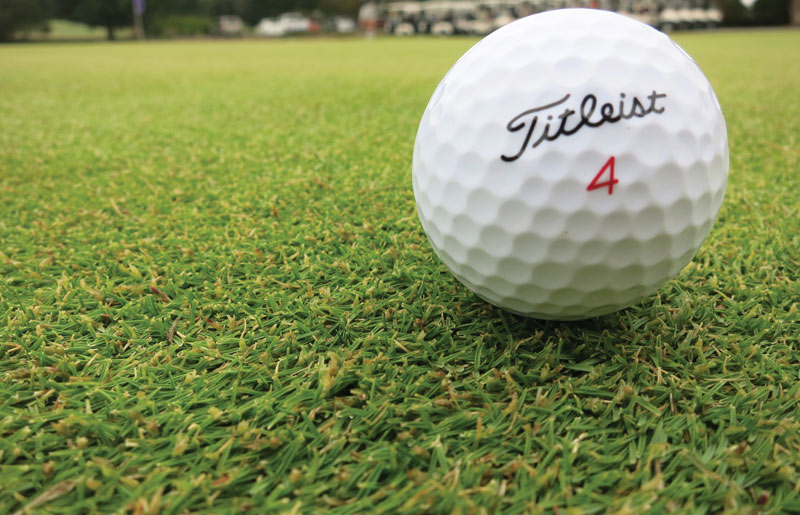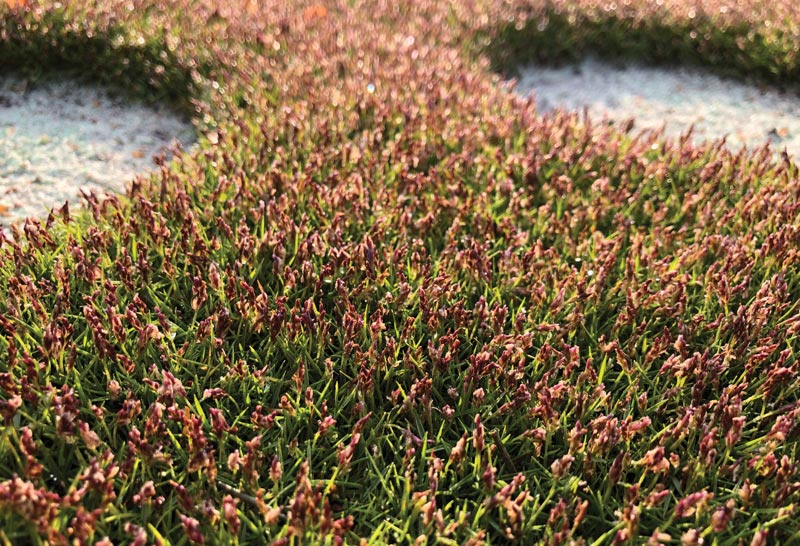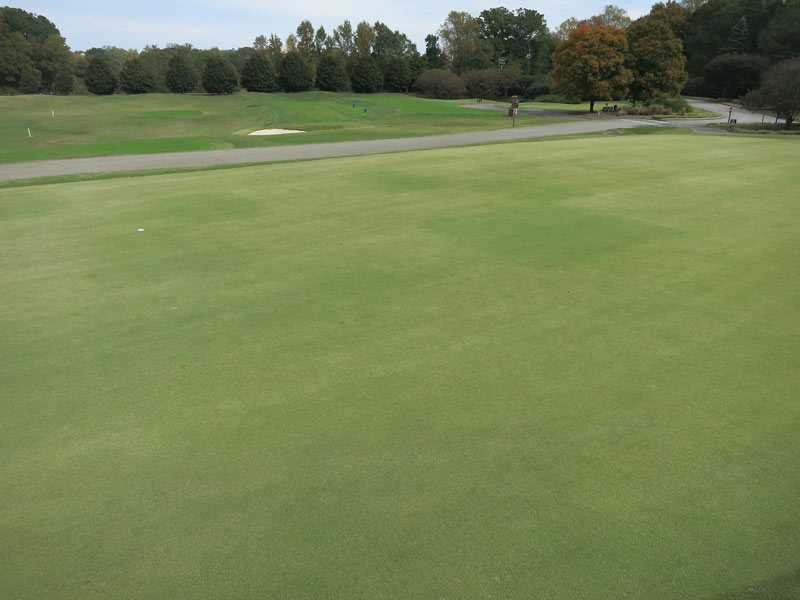
Diamond zoysiagrass seedhead presence affects ball roll smoothness and distance. Seedheads typically protrude from the canopy as the day goes on, creating inconsistencies in height and texture. Photos by Silas Ledford
Zoysia recently joined the few warm-season species used as putting green turf. Zoysia species have a slightly larger adaptable range than other warm-season grasses because they require less light and tolerate slightly lower temperatures (5, 9).
Diamond (Zoysia matrella), which was released by Texas A&M in 1999, has a high tolerance of shaded environments, especially when Primo Maxx (trinexapac-ethyl, Syngenta) is applied (1, 8, 9). This gives Diamond an advantage over ultradwarf bermudagrasses, which require relatively high amounts of light (2). Diamond has also exhibited higher salinity tolerance than many other Zoysia cultivars, which makes it an option in areas where irrigation water quality is not ideal (7). Like other Zoysia species, Diamond has an even number of chromosomes and, to date, has not shown the unstable genetics often displayed with ultradwarf bermudagrasses (3).
Diamond zoysiagrass is not without fault. It has slower lateral growth than nearly all Zoysia species, slowing recovery time from ball marks and core aerification (10). Sprigged Diamond greens also require at least 12 weeks to reach 100% coverage (11), prompting many superintendents to use sod. In a study with 34 other Zoysia species and cultivars, Diamond was least tolerant to freezing, requiring the use of putting green covers when temperatures are expected to remain in the low 20s F (-6.6 C to -4.4 C) (5). A significant problem in Diamond putting greens is seedhead production in spring and fall (3), which typically has a negative impact on ball roll smoothness.
A recent study used photoperiod and accumulated growing degree days (GDD) (base 50 F from Jan. 1) to measure the timing of Diamond seedhead production (4). Initial seedhead production occurred from 301 to 353 GDD in spring and from 3,508 to 4,014 GDD in fall. Photoperiod ranged from 12.7 to 12.9 hours in both spring and fall (4). However, the turfgrass in this study was not maintained at putting green mowing height.
Field observations on Diamond greens at Clemson University have demonstrated that cultural practices such as lowering mowing heights, light vertical mower grooming and brushing before mowing do not reduce seedhead pressure sufficiently to maintain putting green standards. These practices can also cause unwanted turf damage in spring and fall when seedheads are present.
Methods
Separate greenhouse recovery and field studies were conducted at Clemson University’s greenhouse complex and on the Walker Golf Course on campus in 2018 and 2019, where greens were converted to Diamond zoysiagrass in 2014. The objectives of these studies were to evaluate methods for timing initial seedhead emergence in order to study the effects of plant growth regulators on lateral recovery, turfgrass quality, clipping mass and seedhead production.
For the greenhouse work in this study, 4.25-inch (10.8-centimeter) plugs were collected from a nursery green at the Walker Course, and 1.5-inch (3.81-centimeter) cores were removed from the center of each plug to analyze recovery lateral-growth rates. Both greenhouse and field studies used randomized complete block designs with four replications, and results were analyzed using statistical software.
Plots in the field trial were 4.9 × 8.2 feet (1.5 × 2.5 meters). Treatments (Table 1) were applied only once before seedhead emergence each season, approximately on March 14 and Sept. 14. In the greenhouse recovery trial, treatments were applied on four-week intervals beginning Jan. 2, 2019. Treatments in all trials were applied using a backpack sprayer delivering 20 gallons/acre (187 liters/hectare) carrier volume through TeeJet 8003 flat-fan nozzles.
Four hours after treatment, overhead irrigation equal to 0.5 inch (1.27 centimeters) was applied to allow plant uptake of foliar-absorbed plant growth regulators before incorporation of root-absorbed plant growth regulators into the soil. Field trial plots were mowed daily at 0.125 inch (3.2 millimeters), and recovery plugs were mowed three times weekly at 0.200 inch (5 millimeters). Foliar fertilizer equivalent to 0.2 pound nitrogen/1,000 square feet/month (9.8 grams nitrogen/square meter/month) was applied in all studies.

In fall, severe seedhead pressure on Diamond zoysiagrass putting greens may impact quality of cut and playability. A reduction in mowing around research plugs allowed seedheads to mature. This showed mowing is a cultural practice somewhat sufficient in reducing seedhead pressure.
The first date of seedhead observation in control plots determined the photoperiod and accumulated growing degree days (GDD) (base 50 F) for that season. Turfgrass quality was rated (on a 1-9 scale, where 9 is the best, 1 is the worst, and <7 is unacceptable for putting greens) at three, seven, 14 and 28 days after treatment (DAT) in the field. Seedheads were counted within 2.75-inch × 2.75-inch (7-centimeter × 7-centimeter) random samples at 14, 28, 42 and 56 DAT in the field. Percent recovery was rated every 28 days using photographs of a 1.5-inch grid over the removed core and counting squares where green tissue was present.
Results
Initial emergence
We correlated photoperiod and growing degree days with initial emergence dates to accurately predict seedhead emergence. Photoperiod as a predictor of initial seedhead emergence conditions (Table 2) was slightly shorter in this study than in previous research (4), possibly because our research involved greens mowing height rather than the fairway or higher heights in earlier research. A photoperiod of approximately 12.4 hours was a consistent predictor of the initial seedhead emergence across four seasons. GDD showed some variation between years and also varied in the weeks leading to initial emergence between years. The accuracy, consistency and less complex nature of photoperiod measurement makes it a more reliable predictor for a golf course superintendent’s purpose, but more research from additional locations is needed to support these results.
Turf quality
Our objective was to determine whether any treatments increased or decreased turf quality. Turf quality in the field (Table 3) was not consistently improved by any treatment when compared with the control. Treatment with Princep Liquid (simazine, Syngenta) reduced turf quality in fall 2018 to 5.5 at 7 DAT, likely because the irrigation cycle to water-in treatments was delayed 12 hours after treatment because of an irrigation system problem. Undesirable color and reduced density were observed during this time, and significant reductions persisted until 14 DAT.
In fall 2019, with irrigation applied four hours after treatment, the Princep Liquid treatment reduced turf quality to 6 at 3 DAT and was similar to the control by 7 DAT. On all other dates, the Princep Liquid treatment did not affect turf quality. Thorough irrigation immediately after applications of Princep Liquid may further reduce the discoloration and slight density loss observed in this study.
When repeat applications were made in the greenhouse for the lateral recovery study, Primo Maxx, Anuew 27.5WP (prohexadione-Ca, Nufarm), Cutless MEC (flurprimidol, SePRO) and Trimmit 2SC (paclobutrazol, Syngenta) mostly improved turf quality (not shown) compared with the control. Proxy 2L (ethephon, Bayer) reduced turf quality (not shown) following multiple applications.
Seedhead control
We studied seedhead count in the field to determine whether any treatments suppressed seedheads, and, if so, for how long. Seedhead count (not shown) of untreated plots in the field indicated that seedheads were far more abundant and persistent in fall than in spring, with average maximum counts of 25 per 2.75- × 2.75-inch sample in spring and maximum fall counts of 157 per sample. Consequently, few differences were observed among treatments in spring of both years.
Princep Liquid treatments were most effective in reducing seedhead count in fall, reducing counts by 98% of the control at 42 DAT and by 95% at 56 DAT in fall 2019. Princep Liquid treatments in fall 2018 were slightly less effective, reducing seedhead count by 75% of the control at 42 DAT and by 41% at 56 DAT. Again, this may have been a consequence of inadequate incorporation of Princep Liquid into the root zone.

On Nov. 4, 2019 (at 56 days after treatment), treatments containing Princep Liquid showed dark green squares compared with all other treatments, which had abundant light-colored seedheads. Seedhead control for an eight-week duration is unusual and desirable.
No other treatment reduced seedhead count in the field at any date. Applications of Proxy 2L did not affect seedhead counts at any date, contrasting with a report that showed fall application of Proxy 2L in Meyer zoysiagrass fairways reduced spring seedheads (6). These results with Proxy 2L are also in direct contrast to abundant research on Poa annua, where Proxy 2L is routinely used alone or in combination with Primo Maxx to suppress seedheads and improve turf quality.
Editor’s note: New research aims to create a model to guide timing of PGR applications for better zoysia seedhead suppression.
Clipping mass
The objective of measuring clipping mass was to quantify suppression levels among treatments. Treatments of Primo Maxx, Anuew 27.5WP, Cutless MEC and Trimmit 2SC reduced clipping mass similarly (not shown) and therefore would likely increase ball roll distance on putting greens. Treatment with Princep Liquid and Proxy 2L increased the clipping mass, showing growth-promoting qualities. Balancing clipping reduction and turf quality is the fine line walked with plant growth regulators and is largely determined by growing conditions, plant growth regulator rates and application intervals.
Lateral regrowth
The objective of studying lateral regrowth was to determine whether treatments reduced recovery response time from damage or aerification. Recovery response (Table 4) was reduced by Primo Maxx and Anuew 27.5WP at every rating date; these plots took 12 weeks longer than the untreated plot to reach 100% recovery. These results support clipping mass data that showed Primo Maxx and Anuew 27.5WP were among the most effective in reducing clippings. Cutless MEC and Trimmit 2SC also reduced recovery responses compared with the control, requiring an additional 12 and eight weeks to fully recover, respectively. Treatments of Proxy 2L and Princep Liquid had recovery responses similar to those of the control at all dates even though they increased clipping mass.
Recommendations
Frequent applications of Primo Maxx, Anuew 27.5WP, Cutless MEC and Trimmit 2SC while adjusting rates for growing conditions can improve zoysiagrass putting green quality. Princep Liquid treatments were extremely effective in controlling seedhead production and only harmful if not immediately watered-in. Halving the Princep Liquid rate and applying it four weeks apart may extend control in fall and promote greater turf quality.
Lateral recovery was significantly slower in plots treated with Primo Maxx, Anuew 27.5WP, Cutless MEC and Trimmit 2SC compared with the untreated plots, so applications should be carefully considered around core aerification, around weak areas or during stressful periods.
Finally, an approximately 12.4-hour-day-length photoperiod was a consistent predictor of initial seedhead emergence across four seasons. A number of websites list day lengths that can be used as photoperiod (for example, Sunrise-Sunset).
Acknowledgments
The authors thank Donald Garrett, CGCS, and the staff at the Walker Course at Clemson University for their helpful cooperation and insight with this project. This research was funded through Bert McCarty’s lab and was completed in fulfillment of Silas Ledford’s M.S. degree at Clemson University in December 2019.
The research says ...
- Zoysiagrass greens may suffer from seedheads that disrupt play and aesthetics.
- Greenhouse and field studies were undertaken to evaluate methods for timing seedhead emergence and to study the effects of PGRs on turf recovery and quality and clipping and seedhead production.
- Day length was an accurate predictor of seedhead emergence.
- Only one product, Princep Liquid, consistently reduced seedhead production.
- Three of the products tested improved turf quality in the greenhouse; clippings and lateral recovery were significantly slowed by four of the six products tested.
Literature cited
- Atkinson, J.L., L.B. McCarty, H. Liu, J. Faust and J.E. Toler. 2012. ‘Diamond’ zoysiagrass golf green response to reduced light environments with the use of trinexapac-ethyl. Agronomy Journal 104(4):847-852 (https://doi.org/10.2134/agronj2011.0383).
- Bunnell, B.T., L.B. McCarty and W.C. Bridges Jr. 2005. Evaluation of three bermudagrass cultivars and Meyer Japanese zoysiagrass grown in shade. International Turfgrass Society Research Journal 10:826-833.
- Forbes, I. 1952. Chromosome numbers and hybrids in Zoysia. Agronomy Journal 44(4):194-199 (https://doi.org/10.2134/agronj1952.00021962004400040008x).
- McCullough, P.E., J. Yu and S.M. Williams. 2017. Seedhead development of three warm-season turfgrasses as influenced by growing degree days, photoperiod, and maintenance regimens. International Turfgrass Society Research Journal 13:321-329.
- Patton, A.J., and Z.J. Reicher. 2007. Zoysiagrass species and genotypes differ in their winter injury and freeze tolerance. Crop Science 47(4):1619-1627 (https://doi.org/10.2135/cropsci2006.11.0737).
- Patton, A.J., G.P. Schortgen, J.A. Hoyle, M.S. Harrell and Z.J. Reicher. 2018. Fall applications of proxy (ethephon) suppress spring seedheads of ‘Meyer’ zoysiagrass. Crop, Forage & Turfgrass Management 4(1):180012 (https://doi.org/10.2134/cftm2018.03.0012).
- Qian, Y. L., M.C. Engelke and M.J.V. Foster. 2000. Salinity effects on zoysiagrass cultivars and experimental lines. Crop Science 40(2):488-492 (https://doi.org/10.2135/cropsci2000.402488x).
- Qian, Y.L., M.C. Engelke, M.J.V. Foster and S. Reynolds. 1998. Trinexapac-ethyl restricts shoot growth and improves quality of ‘Diamond’ zoysiagrass under shade. HortScience 33(6):1019-1022 (https://doi.org/10.21273/HORTSCI.33.6.1019).
- Sladek, B.S., G.M. Henry and D.L. Auld. 2009. Evaluation of zoysiagrass genotypes for shade tolerance. HortScience 44(5):1447-1451 (https://doi.org/10.21273/HORTSCI.44.5.1447).
- Sladek, B.S., G.M. Henry and D.L. Auld. 2011. Effect of genotype, planting date, and spacing on zoysiagrass establishment from vegetative plugs. HortScience 46(8):1194-1197 (https://doi.org/10.21273/HORTSCI.46.8.1194).
- Stiglbauer, J.B., H. Liu, L.B. McCarty, D.M. Park, J.E. Toler and K. Kirk. 2009. ‘Diamond’ zoysiagrass putting green establishment affected by sprigging rates, nitrogen sources, and rates in the southern transition zone. HortScience 44(6):1757-1761 (https://doi.org/10.21273/HORTSCI.44.6.1757).
Silas Ledford received his undergraduate degree from the University of Georgia and his M.S. degree at Clemson University and is currently a member of the maintenance team at Pinehurst No. 2. Bert McCarty is a professor of turfgrass science and management in the Department of Plant and Environmental Sciences and a member of the Cooperative Extension’s Horticulture Program Team at Clemson University, Clemson, S.C. Nate Gambrell has been McCarty’s lab technician since completing his M.S. at Clemson.